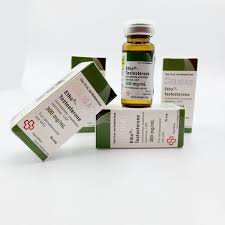Testosterone 300mg 10ml
kr500.00
Testosterone Enanthate is one of the many esterified variants of testosterone available. It is an injectable compound with a slow release rate due to the larger Enanthate ester bound to the testosterone molecule. This enhances testosterone release rate and half-life to a slower release. The majority of testosterone products that have been designed are single products that contain a single esterified form, as opposed to testosterone products that consist of a mixture of several different esterified variants in the fluid (for example, Sustanon 250). Testosterone that is not esterified has a very short half-life, which makes its use very inconvenient and impractical (Testosterone suspension is one such testosterone product that consists of pure unesterified testosterone and does not have an ester bound to its structure). The enanthate ester expands the half-life of testosterone to that of ten days, and blood plasma levels of the hormone remain elevated for a total period of about 2-3 weeks. Testosterone itself is considered to be the most natural and safest anabolic steroid that an individual can use, and it is easily the most versatile and flexible anabolic steroid in terms of how it can be used in cycles and for different purposes and goals.















Reviews
There are no reviews yet.